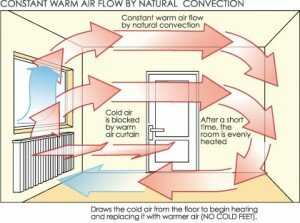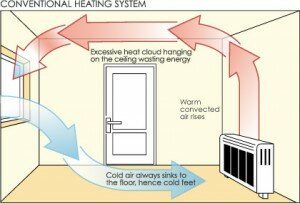Electric Heater Running Costs
This is probably the number 1 question we get asked and understandably especially if you have been using night storage heaters and electric panel heaters, as those type of electric heater have the highest running costs
Do you believe the claims being made?

There are many misleading claims being made by suppliers who have little or no experience in Electric Heating – and they always claim that their heaters have really low running costs. Unfortunately these claims are simply untrue, so we would advise you to check on the type of electric heater and the internal construction and number of heater elements
Things that will affect the running costs
Listed below are just some things to consider and that can severely make a difference to choosing the right heater.
Age of property – older homes with poorer insulation are harder and more expensive to heat
- Amount of loft insulation – if there is little or none it will cost more to heat
- Direction that the room to be heated faces – North facing rooms need much more heat than others
- Where in the UK the property is – homes in the Scottish Highlands/Welsh mountains need more heat than those in the South
- Single or Double Glazed – single glazed will lose more heat
- Whether rooms are on upper or lower floors
Any of these factors make a difference to the correct selection. We use the renowned Hevacomp software which accurately does all of the above for us and is the most accurate when working out how much heat you need for your rooms.
Would you be happy with radiators that you bought off a price list that don’t heat your room or house properly?
There is nothing wrong in getting comparisons from different companies but as the saying goes – buyer beware! These claims are designed to get you to buy a product which cannot be any more efficient because of the basic laws of physics. The objective here will dispel any of the myths.
Impossible savings
To say that a radiator is saving 60% below other comparative products cannot be substantiated. There are just too many factors which will determine the running costs of any type of heating system – not just electric.
Your home itself will determine the amount of heat that it loses. In other words what affects the running costs and what your bills will be
The only way to truly work out what savings will be – if any! is to gather the above required information from you and then input it into the aforementioned specialist computer software which will calculate the heat loss – which will then work out the amount of heat you have to put in to overcome the amount of heat your home will lose.
Other factors to consider
For instance when you are considering replacing Dimplex Storage Heaters, you need to consider how your system works now, and if it suits your lifestyle (i.e. are you out at work whilst you home is being heated?) This factor alone should make you consider new more efficient Electric Radiator Heaters. As you will have seen by look around the internet, there are many differing systems, including Panel Electric Heaters, Dimplex radiators, Oil filled radiators, Gel Electrical Heaters, German Electric Heaters, Ceramic Electric Heaters and other types, so please make sure you do your homework and please don’t just buy a cheap electric heater, otherwise your electric bills could be huge.
An electric heater of any type by any manufacturer is measured by its output, which is in direct relation to the size and number of heater elements inside. So if it says it is a 1.5Kw heater it will produce 1.5Kw of heat, and as all electric heaters are 100% efficient it also means that it will consume 1.5Kw! These are facts that cannot be changed no matter what the make is.
The following are facts – laws of physics:
- A 1Kw heater, will consume 1Kw of electricity to produce 1Kw of heat.
- This same 1Kw heater will consume the above 1Kw at whatever price you are paying per one hour of use (Kw/hour).
- Therefore if you are being charged 13p per Kw/hour the radiator will cost you 13p for one hour of use, or 15p if thats what you are paying.
What differs between makes and therefore the running costs is how they are controlled, how the heat is dissipated, and whether they have a storage capacity, and below is a quick summary of what to look for if you want the lowest running costs.:-

Good Air flow – drawing air from the bottom through the radiator and therefore picking up the heat produced quickly and using both radiant heat (from the front and sides) and convected (through the top) will get the room up to temperature as fast as possible – a convector heater – such as a storage heater or panel heater is designed to pump heat in out of the top of the heater which will rise to the top of the room and will stay there – which is great if you are a giant with a head cold!
A storage capacity - unlike a storage heater which has very poor air flow as per the diagram can only build up a store heat over a long period overnight, a radiator that has multiple elements that heat up multiple special ceramic or fire clay cores that have a shorter storage capacity but with fast warm up means that once the room temperature has been reached, the radiator will stop consuming electricity and use the stored heat to maintain the room temperature for up to 40 minutes means that thi s is the most efficient way of using electricity to heat efficiently.
s is the most efficient way of using electricity to heat efficiently.
So taking the same 1Kw radiator above, once the room is up to temperature it will stop consuming electricity for approximately 40 minutes and will then use the stored heat to maintain the room temperature and will only switch back on again once the room temperature drops. Therefore once up to temperature the calculation becomes 13p divided by 60 (minutes) multiplied by 20 (60 minutes less 40 minutes stored heat) = 20 multiples by 0.13 = 0.43p for the 1 hour consumed.*
* Obviously the length of time that the radiator uses stored heat is dependant upon a variety of factors such as direction the room faces and levels of insulation, age of property etc all of which can affect the running costs. The above is an example only and your own property details should be factored into the picture.
Programmable thermostats – want to be able to manage individual rooms or zones on both time and temperature? Being able to to control when and how you use each room or area by means of switching them on/off at times that you programme and that you control the temperature to within 0.5C based on external conditions all without the need to install special cabling.
Warranties - Obviously the longer the warranty the more confident the manufacturer is that there radiators will stand the test of time
Aluminium vs Steel - The style and design of the radiators will have an impact on their performance, as the chances are that the aluminium radiators will have been either die cast or extruded meaning that they can be more creative with looks and functionality. Also Aluminium warms up quicker and cools down faster, however very good comparable performance tests can be achieved with steel designs too.
Ceramic types vs Oil/Gel filled types - As mentioned above by using a mixture of stored and instant heat the ceramic types have major advantages over the Gel/Oil filled types, and this is normally reflected in the purchase prices and warranty. Gel/Oil filled types will have a single heater element that will always switch on its full capacity (i.e. 1.5Kw of consumption if it is a 1.5Kw output radiator) just to top the room temperature up. Oil has a limited capacity to hold heat and is therefore switching on/off more frequently to maintain the room temperature. The in-built thermostat normally overshoots the desired temperature to allow it to cool down later.
Hopefully by comparing these features that will enable you to make up your mind a little easier and to help you to avoid being a victim of false hopes and claims
How to conserve Energy and reduce CO2 emissions

Old electric storage heater systems are inefficient have little or no control, and you have to worry about the running costs. Electric heating systems and in particular Night Storage Heaters have always been perceived as expensive to run and with little or no control, and rightly so when you look at the lack of control and costs of running electric storage heating working on Economy 7.
We only supply highly Energy Efficient Thermapanel electric radiators, that are tried and tested with excellent reliability. and are slim in size and have similar operation of ‘wet’ radiators, and with even more full control, which is vital when wanting to keep a check on one of the largest outlays.
Gas and Oil prices continue to rise, and the government has committed the long term future for electricity using Nuclear Power. This means having to buy in gas supplies from foreign countries for the foreseeable future. Many properties are in areas where there is no mains gas, and therefore the options for heating the home are limited, can be expensive, unsightly and have poor control.
To minimise running costs we recommend that the radiators are used sensibly and by completing the form below you can receive a free full independent report with a wide range of energy saving recommendations and tips.


